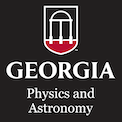Events Calendar View
-
CSP Lunch Seminar
Aug 30, 2011
An Introduction to LAMMPS Molecular Dynamics Simulator
-
Departmental Colloquium
Sep 8, 2011
Higgs and top quark physics in high-energy colliders

Guest: Dr. Nikoloas Kidonakis, Kennesaw State University, Department of Biology and Physics
Thursday, September 8, 2011 4:00 pm - 5:00 pm
Location: Auditorium, Physics 202I present a brief overview of the Standard Model of particle physics, its theoretical underpinnings in Quantum Field Theory, and its experimental verification in high-energy colliders. I discuss two major aspects of current particle physics research: the search for the Higgs boson and the study of the top quark.
-
CSP Lunch Seminar
Sep 13, 2011
Computational Studies of Atomic and Molecular Scattering
-
Departmental Colloquium
Sep 15, 2011
Making the Milky Way -- A Continuing Saga

Guest: Dr. Jay Lockman, National Radio Astronomy Observatory, Green Bank
Thursday, September 15, 2011 4:00 pm - 5:00 pm
Location: Auditorium, Physics 202This talk will be in two parts. First I will describe the Green Bank Telescope, a 100-meter diameter radio telescope that is one of the largest moving objects on land, and, owing to recent upgrades, is now our largest mm-wave radio telescope. I'll discuss its unusual origin, its capabilities, and topics from some of its recent scientific programs including the search for gravitational radiation, Mercury's molten core, interstellar anions, and the growth and evolution of galaxies.
The second part of the talk will continue the topic of growth and evolution of galaxies, with a focus on the Milky Way. Several lines of evidence indicate that our Galaxy must have been accreting low metallicity gas at the rate of about 1 solar mass per year for a substantial portion of its life, but the details of this process are unclear as is the origin of the fresh material. Observations in the 21cm Hydrogen line have recently found a dramatic example of this process in action in the form of a cloud with more than a million solar masses of gas on a trajectory to intersect the Milky Way disk in a few tens of million years. I will discuss this object and the information it gives us on evolution of the Galaxy, the structure of the gaseous halo,and its possible relationship to dark matter halos.
-
CSP Lunch Seminar
Sep 20, 2011
Using GACRC resources: shell, compilers and running jobs
-
Departmental Colloquium
Sep 22, 2011
New Insights into the Influence of Nano-Structure on Exciton Dynamics

Guest: Dr. Ken Knappenberger, Florida State University
Thursday, September 22, 2011 4:00 pm - 5:00 pm
Location: Auditorium, Physics 202Shape- and crystal structure-dependent exciton dynamics of semiconducting nanoparticles were investigated using time- and polarization-resolved magneto-photoluminescence spectroscopy. Experiments were performed at low temperature (<2 K) in magnetic fields up to 17.5 T to investigate spin-dependent radiative relaxation in CdSe quantum dots and nanorods. In contrast to 0-D quantum dots, one-dimensional CdSe nanorods displayed a high degree of spin polarization even at relatively low magnetic field strengths (2 T). The observed spin polarization, evident in intensity-integrated and wavelength-resolved photoluminescence and time-correlated single-photon counting measurements, resulted from spin-polarized excitons that were formed upon highly efficient mixing of “dark” and “bright” fine-structure states. The relative population of these fine-structures was dependent upon the strength of the applied magnetic field. These results demonstrate the potential use of particle shape and crystal structure, two key nanostructure design parameters, to control photoinduced nanoscale dynamics. The findings may impact significantly technologies such as solar-to-electric energy conversion, spintronics, and chemical lasers, which all employ the nanocrystal platform.
Page 23 of 121, showing 6 records out of 723 total, starting on record 133, ending on 138

